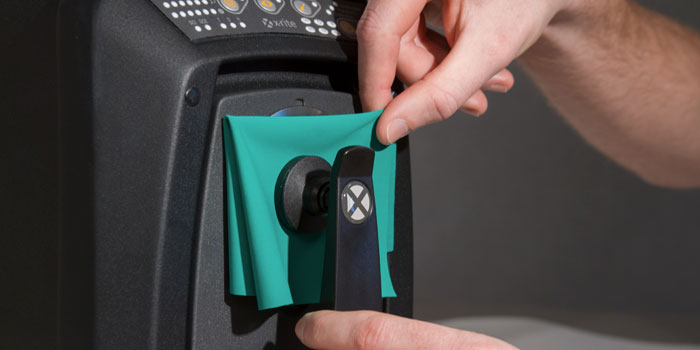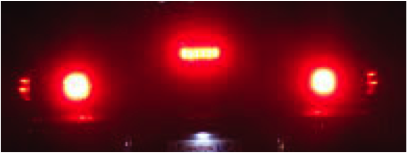Benchtop spectrophotometers measure in either transmission or reflectance mode to capture and quantify color on various opaque, transparent, and translucent samples, including glass, liquid, fabric, and plastic. Today we’ll explain the difference between transmission and reflectance measurements so you can determine which benchtop will meet your color measurement needs.

Transmission vs. Reflectance Measurements
Both transmission and reflectance spectrophotometers emit all of the wavelengths of light from 360 -750 through the flash, then measure the light that is transmitted or reflected to create a quantified graph – a fingerprint – of that color. The dominant wavelengths that reflect back indicate the color. Purples, indigos, and blues have shallow wavelengths, from 400 – 550. Greens are in the middle, from 550 – 600. Yellows, oranges, and reds provide the longest wavelengths. OBAs and fluorescent agents – the outliers – peak over 100%.

Reflectance spectrophotometers measure color by flashing light onto the surface of the sample and measuring the percentage of reflection at 10 nanometer increments. If you’re measuring surfaces that are completely opaque, a reflectance spectrophotometer can do the job.
On the other hand, spectrophotometers that are capable of transmission can project light through the sample. Detectors on the other side pick up the wavelengths and amount of light that made it through and quantify it as a percentage of average transmission.
The Ci7000 Series
The Ci7000 Series of benchtop sphere spectrophotometers includes four models to meet a variety of color measurement needs, all of which conform to ASTM D2244. Here’s how to choose the best for you.
Reflectance Only Measurements
Ci7500: The introductory model in the series, the Ci7500 is a mid-range spectrophotometer that only measures in reflectance mode. If you only need surface measurements of an opaque material like painted parts, the Ci7500 reflectance spectrophotometer may be a good choice. If you need a device that can also measure transmission, the Ci7500 will not work for you.
Ci7520: The Ci7520 reflectance benchtop sphere spectrophotometer is a USDA-approved solution for orange juice color measurement and grading. Using a magnetically attached test tube holder to present the sample without contaminating the instrument, and the Ci7520 measures in reflectance mode to capture accurate color on orange juice as well as other liquids.
Reflectance and Transmission Measurements
The Ci7600, Ci7800, and Ci7860 benchtops measure in both transmission and reflectance modes, ideal if you measure both opaque and translucent samples. Each model is capable of taking four types of measurements:
- Direct transmission measurements for transparent samples that you can see through, such as zipper baggies and clear pane glass.
- Total transmission measurements for translucent samples that allow light to pass through, but you can’t clearly see through, such as laundry detergent and 2-liter bottles.
- Haze measurements for translucent samples that scatter light, such as the plastic cover of a vehicle’s brake light, which scatters red light instead of showing the bulb and filament. Whether you want to include or exclude haze, these devices meet ASTM D1003 – Procedure B standard methods for specification and quality control.
- Standard reflectance measurement at the front port with different size apertures

If you only need surface measurements of a material, the Ci7500 reflectance spectrophotometer may be a good choice. While you can measure surfaces that transmit light in reflection mode, you have to be aware of the translucency of the sample. It all boils down to the data you need.
Are Your Samples Really Opaque?
Measuring transmission and opacity are not always synonymous because opacity can be considered in two natures: to occlude a surface or substrate, or the ability of a material to transmit light.

You may think your hand is opaque, and in a sense it is. But when you press a flashlight up against it you can see the light through the other side. Image from CoolScience.org.
The Difference Between Translucent and Transparent Samples
Translucent objects allow light to shine through but obstruct your view. An etched plastic shower door is translucent. Transparent objects, like a pane of glass, allow you to see objects clearly through the other side.
Practical Applications
Think paint – is it opaque? Yes, when painted on a wall it will cover the substrate so you can’t see through it. But you would need to analyze the paint using the contrast ratio method to see if it is truly opaque. Paints are usually opaque once applied to a substrate, making them a good candidate for the Ci7500.
What about plastic? While we may not be able to see through a plastic sample, it may have the ability to transmit light. Although a plastic bottle may appear opaque, but you don’t know for sure until you test it. For example, the contents of a hydrogen peroxide bottle are quickly degraded by sunlight. This type of bottle is manufactured in a brown color that acts as a blocker to sunlight. However, if you hold a strong light up to it, it will shine through. These bottles are manufactured to be as opaque as possible, considering the cost of hydrogen peroxide does not allow for strict quality parameters.
Textile applications also have to consider their choice of spectrophotometer based on the type of work. AATCC tells us to fold samples into four surfaces to gain opacity. While this is sufficient for measuring a pair of corduroy pants or a roll of cotton fabric, it might make more sense to consider other quantification methods for a sheer or thin semi-transparent nylon material.
Keep in mind if you are measuring textile materials that specify the amount of light that can pass through, ASTM test method 203 of light blocking requires using a spectrophotometer with transmission capability.
What Type of Benchtop Do You Need?
If you only measure 100% opaque surfaces that can’t transmit light, the Ci7500 may be for you. If you mostly measure opaque surfaces but sometimes measure color on objects that allow light to pass through, you may want to consider a device that can take transmission measurements like the Ci7600 or higher. These systems adhere to ASTM D1003 for haze, ASTM E1348 – Std. Test Method for Transmittance and Color by Spectrophotometry Using Hemispherical Geometry, and ISO 22892 transmittance standard.
For example:
- If you’re a smaller molder or plastics processers who strictly works with opaque materials, you may be able use the Ci7500. If you think you might need transmission capabilities in the future, consider that before your purchase. If you’re a plastics processer who needs the ability to also measure translucent items, you probably need the power of the Ci7600 or higher.
- Many paint applications select benchtops for their high level of accuracy, but don’t necessarily need to measure transmission. If you will never encounter the need for transmission measurements, the Ci7500 may be an economical choice.
- If you measure materials like solar sails, outdoor umbrellas, or beach tents for children, they must be tested for light blocking capabilities. The Ci7600 or higher conform with ASTM test method 203 of light blocking procedures. If you’re just measuring men’s ties or leather, the Ci7500 may be sufficient.
We know choosing the right benchtop is not an easy decision, especially when it comes to reflection and transmission. Contact us to discuss your specific applications and one of our Color Experts can help.
